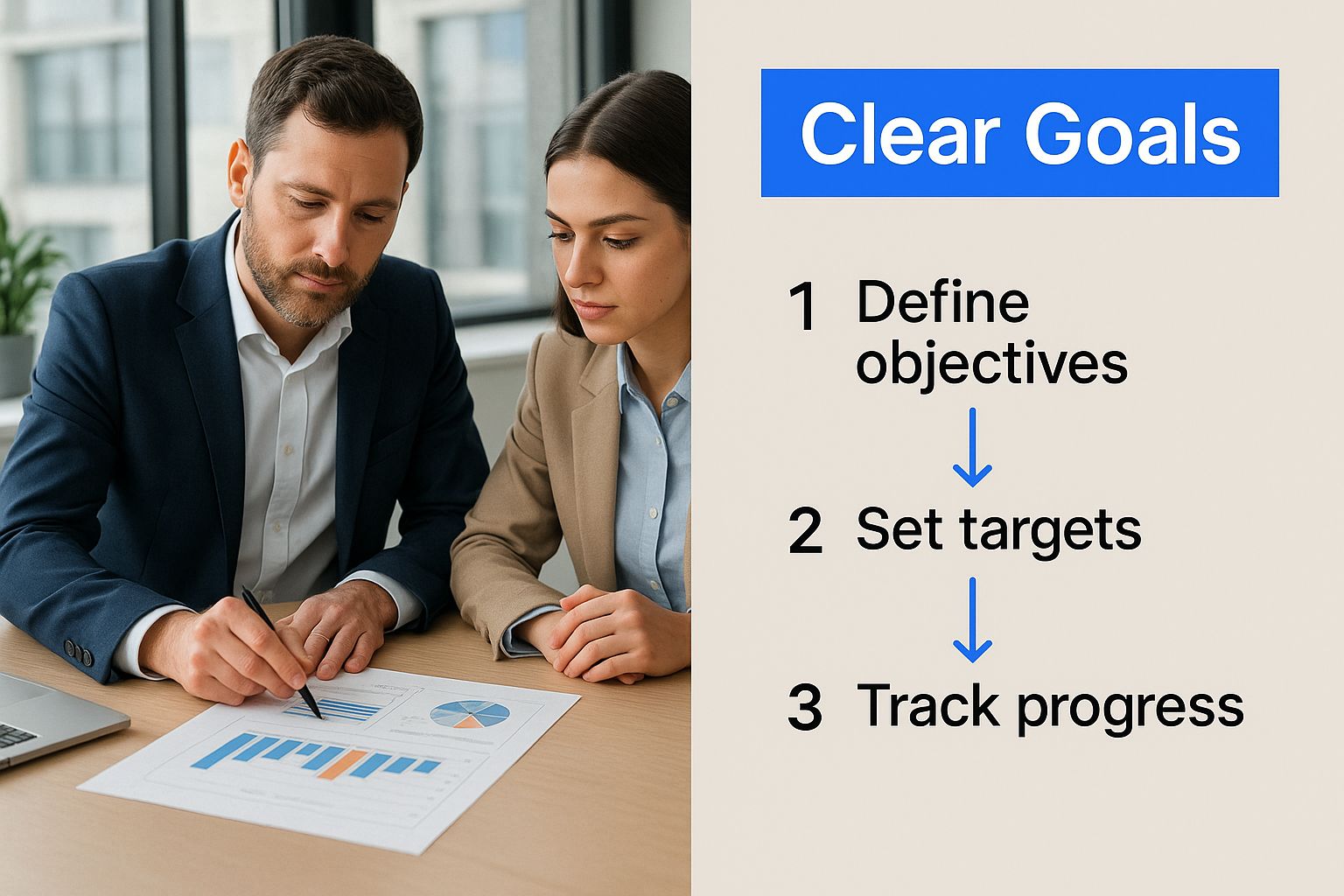So, what’s the secret to boosting staff productivity?
The short answer is there’s no single secret. It’s a deliberate strategy that involves empowering your people, cleaning up your workflows, and making communication crystal clear. Forget the old "just work harder" mentality. We need to tackle the real, tangible issues that slow down modern teams, from the constant ping of notifications to the exhaustion of juggling too many apps.
Rethinking the Modern Productivity Challenge
Ever look at your team and feel a disconnect between the effort you see and the results you're getting? It’s a common frustration for leaders. The modern workplace is a strange beast. We have more tools than ever, but often they create more confusion. We're connected 24/7, yet true clarity seems harder to find.
This guide takes a holistic approach. I'll show you that real, sustainable gains come from a smart blend of efficient processes, the right tech, and a culture that actually supports people.
We'll dig into how to spot the inefficiencies holding you back, make process improvements that stick, and lead in a way that encourages top performance. It all boils down to three core areas:
- Process Optimization: Pinpointing and smoothing out the friction in your daily operations.
- Smart Technology: Using tools to amplify your team's efforts, not just add to their workload. For a great example, look at how technology is transforming the hospitality industry today.
- Supportive Leadership: Creating an environment where people feel engaged, valued, and set up to succeed.
The Real Cost of Inefficiency
Inefficiency is more than just lost time—it's squandered potential. The numbers paint a pretty clear picture. While U.S. labor productivity saw a healthy jump of 2.7% in 2023, a massive problem is hiding just beneath the surface.
On average, employees spend a staggering 60% of their work time on "work about work." Think about that. That's time spent switching between apps, sitting in pointless meetings, or just trying to hunt down the right information. It’s a clear signal that we need to get our workflows in order so our teams can focus on what truly drives the business forward.
The goal isn't just to make people busier; it's to make their work more impactful. True productivity is about achieving significant outcomes with less friction, freeing up your team’s cognitive energy for innovation and problem-solving.
Focusing on these core areas is the first step toward building a team that's more resilient, effective, and genuinely motivated. Let's walk through the practical steps to make it happen.
To give you a clear roadmap, I've broken down these concepts into three foundational pillars.
Core Pillars of Staff Productivity Improvement
This table summarizes the strategic areas we'll be focusing on. Think of it as your blueprint for building a more efficient and engaged team.
| Pillar | Focus Area | Key Benefit |
|---|---|---|
| Process | Streamlining workflows and removing bottlenecks | Reduced wasted effort and faster task completion. |
| Technology | Implementing and optimizing the right POS tools | Automation of repetitive tasks and better data access. |
| Management | Fostering a supportive and communicative culture | Higher employee engagement, motivation, and retention. |
By addressing each of these pillars, you create a system where improvements in one area amplify the benefits in the others, leading to a powerful, cumulative effect on your team's overall performance.
Finding the Real Roadblocks Holding Your Team Back
Before you can make your team more productive, you have to put on your detective hat. The biggest wins don't come from telling people to work harder. They come from finding and clearing out the invisible roadblocks that slow everyone down. It's about looking past the surface symptoms to diagnose the root cause.
Think about a busy retail shop with perpetually long checkout lines. The easy answer is to blame the cashiers for being slow. But what if you dug into the point-of-sale (POS) data? You might find the real villain is an ancient credit card terminal that takes forever to process or a clunky system for looking up customer rewards. Suddenly, the problem isn't the person—it's the process.
It’s the same in a restaurant. If orders keep coming out wrong, you could map the entire kitchen workflow. Tracing a ticket from the moment it prints to when it lands on the pass might reveal a critical communication gap between the grill station and the expo. That’s a simple bottleneck, and once you see it, you can fix it.
Digging for Truth with Direct Feedback
Data tells you half the story, but your team holds the other half. The people in the trenches every day know exactly where the friction points are. Your job is to create a space where they feel safe enough to tell you what's really holding them back. This isn't about pointing fingers; it's about making the system better for everyone.
This is where setting crystal-clear expectations becomes your starting point. When everyone knows the goal, it's much easier to spot the obstacles in the way.
To get to the heart of the matter, you need to ask better questions during one-on-ones or in small team huddles. Forget vague questions like, "How can we be more productive?" Get specific.
- What’s the single most frustrating task you have to do every week?
- If you could wave a magic wand and get rid of one part of our process, what would it be?
- Where do you find yourself waiting for someone else to give you information or an approval?
- Which tool or software program gives you the biggest headache?
These kinds of questions don't just ask for opinions; they unearth real, actionable problems. You'll quickly figure out if the issue is a dusty old process, the wrong tools for the job, or just a simple communication breakdown.
Here’s something I’ve learned over the years: the small, daily frustrations are the real productivity killers. Fixing a "minor" annoyance that trips up every single person on your team can have a much bigger impact than tackling one massive, isolated project.
Designing Workflows for Maximum Efficiency
Once you've pinpointed the friction in your operations, it's time to roll up your sleeves and redesign how the work actually gets done. This isn't about writing a massive, rigid manual that will just gather dust on a shelf. The real goal here is to build simple, repeatable systems that take the guesswork out of daily tasks, freeing up your team to focus on what really moves the needle.
When you think about it, boosting staff productivity often just means making the right way to do something the easiest way to do it.
A messy inventory process is a perfect example I see all the time. A manager notices their team is burning hours hunting for stock or trying to sort out frustrating discrepancies. The fix doesn't have to be complicated. It could be as straightforward as a one-page checklist—a Standard Operating Procedure (SOP)—that clearly outlines the steps for receiving, logging, and shelving new items. That small bit of clarity gets rid of confusion and ensures things are done the same way, no matter who is working that day.
Creating Simple and Actionable Systems
The best workflows just make sense. They feel intuitive. They don't force people to stop and think about how to handle routine stuff. Look for ways to cut down on the number of clicks, approvals, or handoffs it takes to complete a common task, whether it's processing a customer return or updating the daily sales report.
This is where you can get a huge assist from automation. So many of those administrative tasks that drain time and kill morale are perfect candidates for it. Consider things like:
- Automated Reminders: Setting up your system to automatically chase unpaid invoices or send appointment reminders to clients.
- Data Entry: Using software that syncs your sales data directly with inventory levels, so no one has to update a spreadsheet by hand.
- Scheduling: Implementing smarter scheduling tools that can optimize your staffing based on historical peak hours and employee availability. You can learn more by exploring some effective workforce management strategies that transform businesses.
By handing off these low-value, repetitive jobs to technology, you give your team their brainpower back for higher-impact work, like talking to customers and solving real problems.
A good workflow makes the correct action the path of least resistance. When the system is designed well, people naturally follow it because it’s the most logical and efficient way to get the job done.
Get Your Team Involved in the Redesign
Listen, the most brilliant process you draw up on a whiteboard is completely worthless if it doesn't work in the real world. This is exactly why getting your team involved in the redesign is non-negotiable.
Your staff are the experts on the ground. They're the ones living with the process every day, and their insights on what will actually make their jobs easier are invaluable.
Pull them in for a quick brainstorming session. Ask them a simple question: "If we were building this from scratch, how would you do it?" Getting their buy-in from the very beginning gives them a sense of ownership over the new system, making it far more likely they'll embrace it instead of fighting it.
To keep your team running at its best, it's crucial to implement practical strategies for improving workplace efficiency, especially in a fast-paced environment. At the end of the day, a workflow that actually works is a team effort—one that makes everyone's job a little easier and a lot more effective.
Using Technology as a Productivity Multiplier
Technology should be your team's best friend, not another source of headaches. When chosen correctly, the right tools can slash tedious work, clear up communication, and give you the data you need to make smarter decisions. But the wrong tech? It just creates more problems than it solves, leading to confusion and a whole lot of wasted time.
It all comes down to being intentional. You're not just adding software; you're strategically choosing systems that genuinely make work easier. Think about a modern POS system. It doesn’t just ring up sales—it automatically updates your inventory, tracks customer history, and handles scheduling. That one tool knocks out hours of manual data entry and gives your team real-time information, freeing them up to actually help customers.
Fighting the Drain of App Switching
One of the sneakiest productivity killers out there is what I call "app switching." When your team has to bounce between a dozen different programs just to get one thing done, they lose focus and momentum with every single click. It's a massive, hidden time-waster.
The fix is to consolidate wherever you can. Look for platforms that handle multiple jobs in one place, like a communication hub that brings together chat, file sharing, and project management.
Interestingly, how we work is changing. The average workday has actually gotten shorter by 36 minutes since before the pandemic, yet overall productivity is up by 2%. This tells us that people are working smarter, not just longer, and technology is a big part of that. Now, with 58% of employees using AI tools, the challenge is making sure this new tech simplifies workflows instead of adding to the digital chaos. You can read the full research about modern workplace statistics to see how this balance is playing out.
The best technology fades into the background. It feels like a natural extension of your workflow, supporting your team without ever getting in the way.
A Practical Checklist for Evaluating New Tech
Before you pull the trigger on any new software or gadget, put it through this simple test. This is how you make sure you’re adding a true productivity booster, not just another shiny object that will collect dust. Answering these questions honestly will save you a ton of time, money, and frustration.
Use this checklist to guide your decision:
- Problem-Solving: What specific, nagging bottleneck does this tool actually solve? If you can't name the exact problem, you don't need the tool. Simple as that.
- Integration: How well does it play with the systems you already use? A tool that can't "talk" to your other software is just going to create more manual workarounds.
- User Experience: Is it actually easy to use? A clunky, complicated interface means a painful learning curve and, most likely, your staff won't even bother using it.
- Scalability: Can this thing grow with you? Think about whether it can handle more customers, more staff, or more locations down the road.
By being deliberate about the technology you bring into your business, you can build a streamlined tech stack that truly empowers your team. The end goal is to reduce friction and give everyone more time to focus on the work that really moves the needle.
Building a Culture of Engagement and Well-Being
You can have the most dialed-in processes and the slickest tech, but if your team is checked out and stressed, you'll never hit your true potential. The final, and arguably most important, piece of the productivity puzzle is the human element—building a culture where people genuinely feel valued, supported, and connected to the bigger picture. This is where those so-called 'soft skills' have a direct, measurable impact on your bottom line.
Boosting staff productivity isn't about cracking a whip; it's about creating an environment where your team feels psychologically safe and genuinely motivated. It all starts with simple, consistent management practices that build trust over time.
Foster Ownership and Provide Meaningful Feedback
Handing over real ownership of tasks is one of the most powerful motivators you have. When employees feel trusted to make decisions and can clearly see how their work contributes to the company's success, their level of investment goes through the roof. That sense of autonomy naturally builds responsibility and pride.
Of course, you can't just hand over the reins and walk away. This approach only works with regular, constructive feedback. It’s time to ditch the once-a-year performance review in favor of frequent, informal check-ins. Consistent guidance helps people stay aligned with team goals and sharpen their skills on the fly.
The foundation of a productive culture isn't control; it's trust. When you give your team the autonomy to own their work and the support to do it well, they will consistently exceed your expectations.
Prioritize Well-Being and Flexibility
Burnout is the silent killer of productivity. Promoting a genuine work-life balance isn't just a trendy perk; it's a strategic imperative. This means actively encouraging your team to step away from their desks, take their vacation days, and truly disconnect when the workday is done. When leadership lives this out, it sends a powerful message that it's okay for everyone else to do the same.
The connection between well-being and performance is crystal clear. Staggering global data shows that 79% of employees are not engaged at work, a problem that costs the global economy an estimated US$8.9 trillion. On the flip side, workplaces that offer flexible conditions report a remarkable 39% jump in employee productivity.
To get there, you have to be intentional about cultivating a culture of engagement where people feel seen and connected.
This isn't as abstract as it sounds. It comes down to a few key actions:
- Celebrate the Wins: Make a point to acknowledge both the major milestones and the small, everyday victories. It reinforces positive behavior and makes people feel appreciated.
- Encourage Open Dialogue: Carve out a safe space where team members can voice concerns or pitch new ideas without fear of being shot down.
- Offer Flexible Options: Where it makes sense for your business, provide flexibility in schedules or location. It’s a powerful way to show you trust your team to manage their own time and get the job done.
When you intentionally build a supportive and engaging environment, you're doing more than just creating a nice place to work—you're laying the groundwork for sustained, high-level performance.
Common Questions About Staff Productivity
Even when you've got a solid plan, you'll still run into questions on the ground. Improving staff productivity is more of an art than a science, so let's walk through some of the most common hurdles I've seen leaders face.
How Do I Actually Measure Staff Productivity?
First things first: stop counting hours. True productivity is about the quality and quantity of what gets done, not how long someone sat in a chair. You need to shift your focus from clock-watching to metrics that actually reflect performance.
This means setting up specific Key Performance Indicators (KPIs) for each role. For a salesperson, that could be their conversion rate or the number of new leads they bring in. For someone in customer support, you might look at customer satisfaction scores or how quickly they resolve issues.
But don't just rely on the numbers. You also need to track how consistently projects are completed on time and gather real feedback during your one-on-ones. If you only monitor activity, you’ll just create a culture of anxiety and destroy trust—the exact opposite of your goal.
Measuring productivity isn't about surveillance. It's about giving your team a clear target to aim for. When you measure what matters, you get real insights that help everyone succeed.
What Are the Biggest Hidden Productivity Killers?
The things that drain your team's productivity are almost never the obvious problems. They're usually the small, annoying parts of the workday that everyone has just accepted as "the way things are." You have to become a detective, looking for the invisible friction that has become normal.
Here are a few of the usual suspects I see all the time:
- Pointless Meetings: Back-to-back meetings with no clear agenda are black holes for time and energy.
- Constant Interruptions: When your team is getting pinged from a dozen different apps, it's impossible to get into a state of deep focus.
- Constantly Changing Priorities: If the goalposts are moving every day without clear communication, your team will spin their wheels and get frustrated.
- "Busy Work" Culture: Watch out for a workplace that rewards looking busy instead of achieving real results. It encourages people to perform work rather than create impact.
How Can I Boost Productivity Without Burning Everyone Out?
This is the big one, and the answer is surprisingly straightforward: work smarter, not harder. The goal is sustainable performance, and that only comes from a system that respects your team's well-being.
Your job is to ruthlessly eliminate friction. Actively remove pointless tasks from their plates and give them tools that genuinely make their jobs easier, not just add another login to remember.
Most importantly, you have to fiercely protect your team's time for uninterrupted "deep work." This might mean setting up "no-meeting" blocks in the calendar or encouraging everyone to use their "do not disturb" status. And it all starts at the top—you have to build a culture where taking breaks, using vacation time, and logging off at a reasonable hour are not just tolerated but openly encouraged.
Ready to give your team tools that get rid of bottlenecks for good? Biyo POS handles everything from sales and inventory to staff management, empowering your team to work smarter. Find out how our all-in-one system can change the way you operate at https://biyopos.com.







